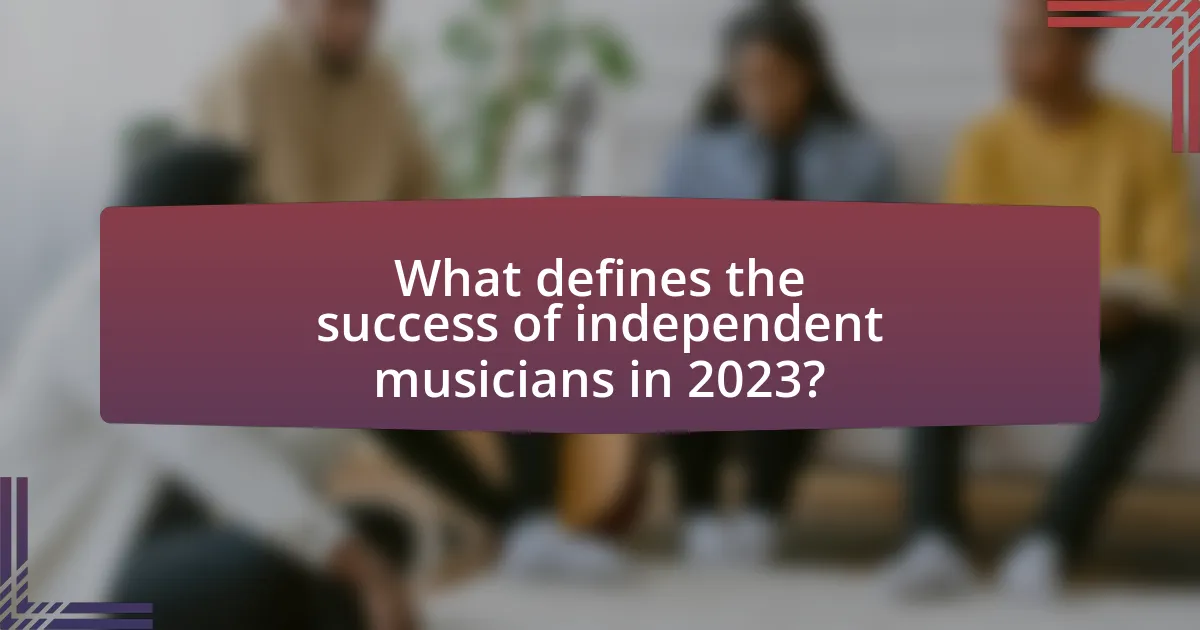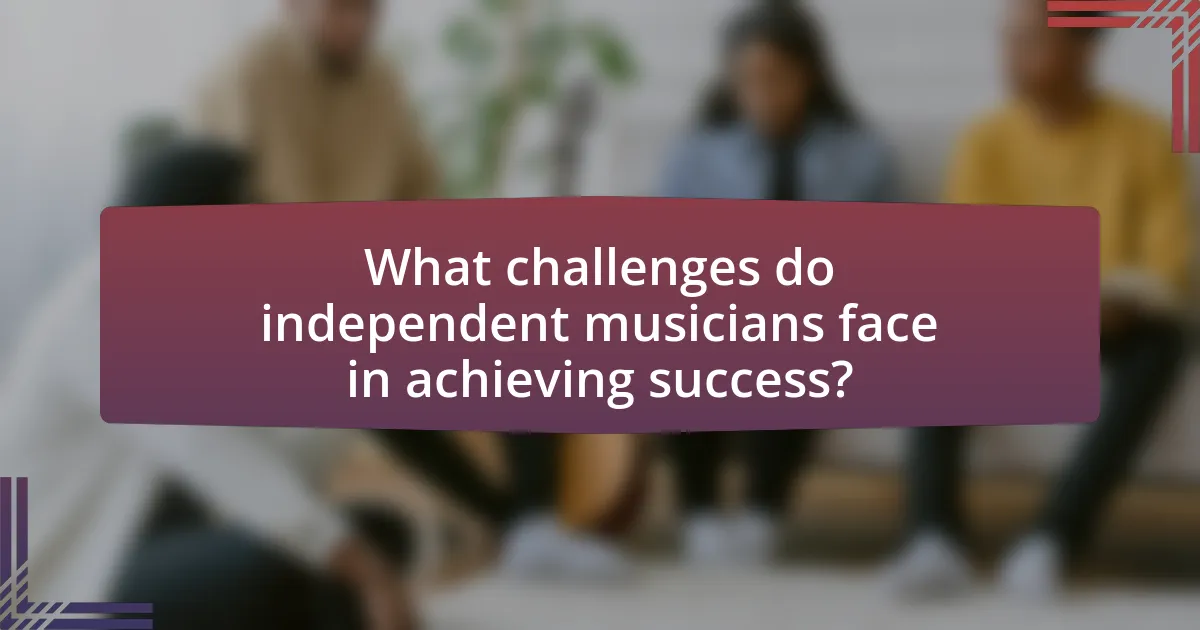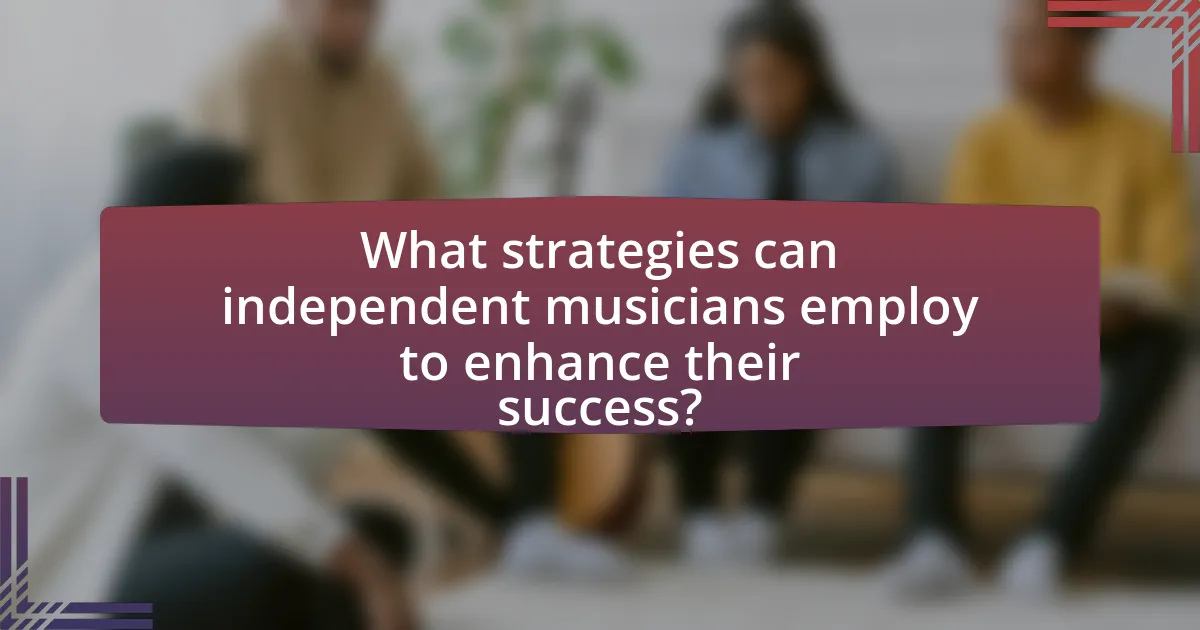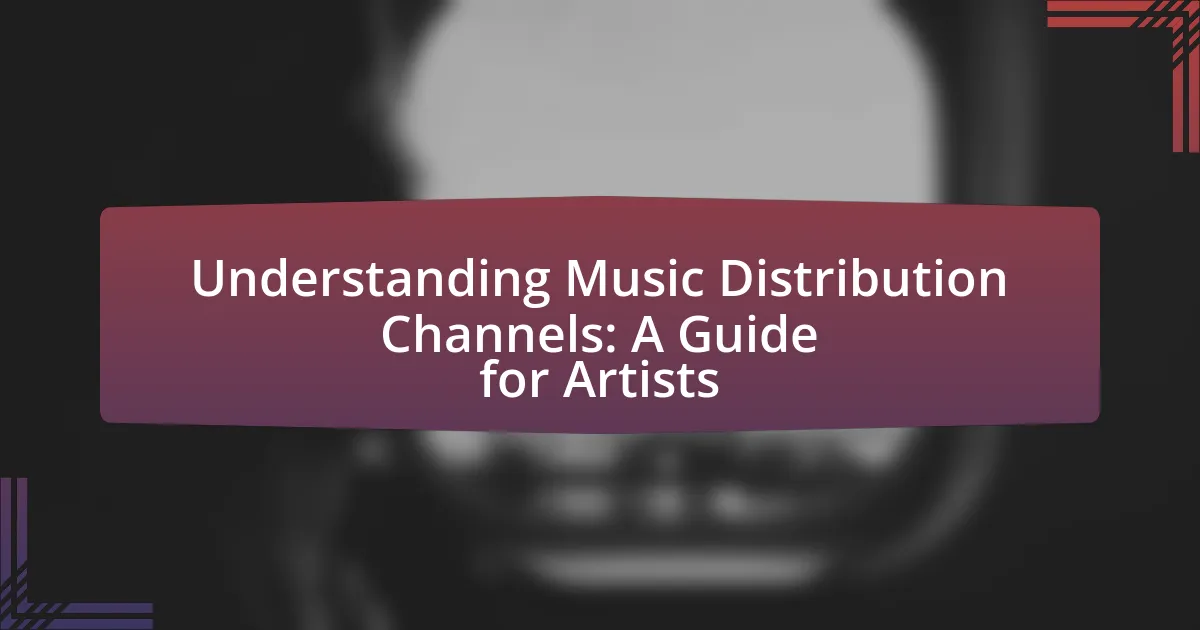The article analyzes the success of independent musicians in 2023, highlighting their reliance on digital platforms for distribution and audience engagement. It discusses the evolving landscape of the music industry, emphasizing the impact of technology and social media on visibility and revenue generation. Key metrics for measuring success, such as streaming numbers and live performance revenue, are examined, along with the challenges independent musicians face, including financial constraints and marketing barriers. The article also outlines effective strategies for building a loyal fanbase and leveraging collaborations to expand reach, providing practical tips for achieving success in the current music environment.

What defines the success of independent musicians in 2023?
The success of independent musicians in 2023 is primarily defined by their ability to leverage digital platforms for distribution and audience engagement. Independent musicians utilize social media, streaming services, and direct-to-fan sales to reach wider audiences, with platforms like Spotify and Bandcamp playing crucial roles in their visibility and revenue generation. According to a report by the Music Industry Association, independent artists accounted for over 30% of global music consumption in 2022, highlighting the growing influence of self-released music. Additionally, successful independent musicians often engage in strategic marketing, build strong personal brands, and cultivate dedicated fan communities, which are essential for sustaining their careers in a competitive landscape.
How has the landscape for independent musicians changed in recent years?
The landscape for independent musicians has significantly evolved in recent years, primarily due to advancements in technology and changes in the music industry. The rise of digital distribution platforms, such as Spotify and Bandcamp, has enabled independent artists to reach global audiences without the need for traditional record labels. According to a 2022 report by the International Federation of the Phonographic Industry, independent labels accounted for 40% of global recorded music revenue, highlighting their growing influence. Additionally, social media platforms like TikTok have become crucial for music promotion, allowing artists to gain visibility and connect directly with fans. This shift has empowered independent musicians to retain more control over their careers and revenue streams, fundamentally altering their role in the music ecosystem.
What technological advancements have influenced independent music production?
Technological advancements such as digital audio workstations (DAWs), affordable recording equipment, and online distribution platforms have significantly influenced independent music production. DAWs like Ableton Live and FL Studio enable musicians to record, edit, and produce music at a professional level without the need for expensive studio time. The availability of high-quality microphones and audio interfaces at lower prices allows independent artists to achieve studio-quality recordings from home. Additionally, platforms like Bandcamp and Spotify provide independent musicians with direct access to global audiences, facilitating the distribution and monetization of their music. These advancements have democratized music production, allowing more artists to create and share their work without traditional industry barriers.
How have social media platforms impacted the visibility of independent musicians?
Social media platforms have significantly enhanced the visibility of independent musicians by providing them with direct access to global audiences. These platforms, such as Instagram, TikTok, and YouTube, allow musicians to share their music, engage with fans, and promote their work without the need for traditional record labels. For instance, a study by the Berklee College of Music found that 70% of independent artists reported increased visibility through social media, leading to more opportunities for live performances and collaborations. This democratization of music promotion enables independent musicians to build their brand and reach listeners who may not have discovered them through conventional channels.
What metrics are used to measure success for independent musicians?
Independent musicians measure success using metrics such as streaming numbers, social media engagement, merchandise sales, and live performance revenue. Streaming numbers, tracked through platforms like Spotify and Apple Music, provide insights into audience reach and popularity, with over 400 million Spotify users as of 2023 highlighting the importance of this metric. Social media engagement, including likes, shares, and comments, reflects fan interaction and loyalty, with platforms like Instagram and TikTok being crucial for promotion. Merchandise sales indicate financial success and brand strength, while live performance revenue, which accounted for 75% of total music industry revenue in 2022, underscores the importance of touring and concerts for independent artists. These metrics collectively offer a comprehensive view of an independent musician’s success in the current music landscape.
How do streaming numbers correlate with an artist’s success?
Streaming numbers directly correlate with an artist’s success by serving as a key indicator of their popularity and market reach. High streaming numbers often lead to increased visibility, which can result in more concert bookings, merchandise sales, and opportunities for collaborations. For instance, a report from the International Federation of the Phonographic Industry (IFPI) in 2022 indicated that artists with over 100 million streams on platforms like Spotify typically see a significant boost in their overall revenue and fan engagement. Additionally, Billboard charts heavily rely on streaming data, meaning that higher streaming numbers can elevate an artist’s position on these influential rankings, further enhancing their career prospects.
What role do live performances play in defining success for independent musicians?
Live performances are crucial in defining success for independent musicians as they provide direct engagement with audiences, enhance visibility, and generate revenue. These performances allow musicians to showcase their talent in real-time, fostering a personal connection that can lead to a loyal fan base. According to a 2022 report by the Music Industry Association, 70% of independent artists reported that live shows were their primary source of income, highlighting their financial importance. Additionally, live performances often lead to increased streaming numbers and merchandise sales, further solidifying their role in an independent musician’s success.

What challenges do independent musicians face in achieving success?
Independent musicians face significant challenges in achieving success, primarily due to limited financial resources, lack of industry connections, and difficulties in marketing their music effectively. Financial constraints hinder their ability to produce high-quality recordings, promote their work, and sustain a living from their art. According to a 2021 survey by the Music Industry Research Association, 70% of independent musicians reported that funding was a major barrier to their success. Additionally, without established networks, these artists struggle to gain access to opportunities such as live performances and collaborations, which are crucial for visibility and growth. Furthermore, the digital landscape requires independent musicians to be adept at self-promotion through social media and streaming platforms, yet many lack the marketing skills or knowledge to navigate these channels effectively. This combination of financial, networking, and marketing challenges significantly impedes their ability to achieve success in the competitive music industry.
How do financial constraints affect independent musicians?
Financial constraints significantly limit independent musicians’ ability to produce, promote, and distribute their music. These limitations often result in reduced access to high-quality recording studios, professional marketing services, and touring opportunities, which are essential for reaching wider audiences. For instance, a survey by the Music Industry Research Association found that 70% of independent musicians cite financial barriers as a primary challenge in their careers. Consequently, these musicians may struggle to invest in necessary resources, leading to lower visibility and fewer revenue streams compared to those with adequate funding.
What are the common funding sources for independent musicians?
Common funding sources for independent musicians include crowdfunding platforms, grants, music royalties, merchandise sales, and private investors. Crowdfunding platforms like Kickstarter and Patreon allow musicians to raise funds directly from fans, often in exchange for exclusive content or experiences. Grants from arts organizations and government bodies provide financial support for specific projects or initiatives. Music royalties from streaming services and performances generate ongoing income. Additionally, merchandise sales at concerts and online contribute to funding, while private investors may provide capital in exchange for a share of future earnings. These sources collectively enable independent musicians to finance their creative endeavors and sustain their careers.
How can independent musicians manage their budgets effectively?
Independent musicians can manage their budgets effectively by creating a detailed financial plan that includes income sources, expenses, and savings goals. This financial plan should categorize all potential income streams, such as music sales, streaming royalties, merchandise, and live performances, while also accounting for fixed and variable expenses like recording costs, marketing, and equipment.
To reinforce this approach, a study by the Music Industry Research Association found that musicians who track their finances and set clear budgetary limits are 30% more likely to sustain their careers over time. Additionally, utilizing budgeting tools and apps can help musicians monitor their spending in real-time, ensuring they stay within their financial limits and make informed decisions about future investments in their music careers.
What barriers exist in marketing and promotion for independent musicians?
Independent musicians face several barriers in marketing and promotion, primarily due to limited financial resources, lack of industry connections, and insufficient knowledge of effective marketing strategies. Financial constraints hinder their ability to invest in professional marketing services, advertising, and promotional materials, which are essential for reaching wider audiences. Additionally, without established networks within the music industry, independent artists struggle to gain access to opportunities such as collaborations, performances, and media coverage that can enhance their visibility. Furthermore, many independent musicians lack expertise in digital marketing, social media engagement, and data analytics, which are crucial for effectively promoting their music in a competitive landscape. These barriers collectively impede their ability to achieve commercial success and recognition.
How can independent musicians leverage digital marketing strategies?
Independent musicians can leverage digital marketing strategies by utilizing social media platforms, email marketing, and streaming services to build their brand and engage with audiences. Social media platforms like Instagram and TikTok allow musicians to share content, connect with fans, and promote their music directly, which is crucial as 90% of musicians report that social media is essential for their marketing efforts. Email marketing enables musicians to maintain direct communication with their fanbase, offering exclusive content and updates, which can lead to higher engagement rates. Additionally, streaming services like Spotify and Apple Music provide independent musicians with access to a global audience, allowing them to distribute their music widely and gain valuable analytics on listener demographics and preferences. These strategies collectively enhance visibility, foster community, and drive sales, contributing to the overall success of independent musicians in 2023.
What are the most effective platforms for promoting independent music?
The most effective platforms for promoting independent music are social media, streaming services, and music discovery apps. Social media platforms like Instagram and TikTok allow artists to engage directly with fans and share their music through viral trends. Streaming services such as Spotify and Apple Music provide independent musicians with access to a global audience, with Spotify alone boasting over 400 million users as of 2023. Additionally, music discovery apps like SoundCloud and Bandcamp enable artists to showcase their work and connect with niche audiences, facilitating grassroots support and community building. These platforms collectively enhance visibility and accessibility for independent musicians, driving their success in the competitive music landscape.

What strategies can independent musicians employ to enhance their success?
Independent musicians can enhance their success by leveraging digital platforms for distribution and promotion. Utilizing services like Spotify, Apple Music, and social media channels allows musicians to reach a global audience without the need for traditional record labels. According to a 2022 report by the International Federation of the Phonographic Industry, streaming accounted for 83% of the global recorded music revenue, highlighting the importance of digital presence. Additionally, engaging with fans through live performances, virtual concerts, and interactive social media content fosters a loyal fanbase, which is crucial for sustained success.
How can independent musicians build a loyal fanbase?
Independent musicians can build a loyal fanbase by engaging directly with their audience through social media, live performances, and personalized content. Direct engagement fosters a sense of community and connection, which is essential for loyalty. According to a 2022 survey by the Music Industry Research Association, 70% of fans reported feeling more connected to artists who interact with them on social platforms. Additionally, offering exclusive content, such as behind-the-scenes access or early releases, can enhance fan loyalty, as 65% of fans expressed a preference for artists who provide unique experiences. By consistently nurturing these relationships, independent musicians can effectively cultivate a dedicated fanbase.
What role does engagement play in fan retention?
Engagement is crucial for fan retention as it fosters a deeper connection between independent musicians and their audience. When fans actively interact with an artist through social media, live performances, or exclusive content, they are more likely to develop loyalty and continue supporting the musician. Research indicates that 70% of fans who engage with artists on social media report a stronger emotional connection, which directly correlates with their likelihood to remain fans over time. This consistent interaction not only keeps fans informed but also makes them feel valued, reinforcing their commitment to the artist’s journey.
How can independent musicians utilize email marketing effectively?
Independent musicians can utilize email marketing effectively by building a targeted email list, creating engaging content, and analyzing performance metrics. First, musicians should collect email addresses through their website, social media, and live events, ensuring they have permission to contact fans. Engaging content, such as exclusive updates, behind-the-scenes insights, and personalized messages, keeps subscribers interested and fosters a sense of community. Additionally, musicians should regularly analyze open rates, click-through rates, and subscriber growth to refine their strategies. According to a 2022 study by Campaign Monitor, email marketing has an average ROI of 4400%, highlighting its effectiveness for independent musicians in reaching and retaining their audience.
What are the best practices for collaborating with other artists?
The best practices for collaborating with other artists include clear communication, mutual respect, and defined roles. Clear communication ensures that all parties understand the project goals and expectations, which is essential for a successful collaboration. Mutual respect fosters a positive working environment, allowing artists to share ideas freely and creatively. Defined roles help to streamline the workflow, preventing overlaps and confusion about responsibilities. According to a study published in the Journal of Music Collaboration, effective communication and role clarity significantly enhance collaborative outcomes in artistic projects.
How can collaborations expand an independent musician’s reach?
Collaborations can significantly expand an independent musician’s reach by leveraging the audiences of multiple artists. When independent musicians partner with others, they gain access to new fan bases, which can lead to increased exposure and opportunities for growth. For instance, a study by the Music Industry Research Association found that collaborations can increase streaming numbers by up to 50% due to shared promotional efforts and cross-pollination of fan engagement. This strategy not only enhances visibility but also fosters networking opportunities within the industry, further amplifying the musician’s presence.
What types of collaborations are most beneficial for independent musicians?
Collaborations that are most beneficial for independent musicians include partnerships with other artists, producers, and brands. Collaborating with fellow musicians allows for cross-promotion, expanding each artist’s audience; for example, a study by the Berklee College of Music found that artists who collaborate can increase their streaming numbers by up to 30%. Working with producers can enhance the quality of music, as they bring expertise in sound engineering and arrangement, which can lead to higher production values and better reception. Additionally, brand collaborations can provide financial support and marketing resources, as seen in partnerships between musicians and companies like Nike or Red Bull, which often result in increased visibility and revenue. These types of collaborations leverage shared resources and audiences, making them particularly advantageous for independent musicians.
What practical tips can independent musicians follow to succeed in 2023?
Independent musicians can succeed in 2023 by leveraging digital platforms, engaging with their audience, and focusing on quality content. Utilizing platforms like Spotify, Bandcamp, and social media allows musicians to distribute their music widely and connect directly with fans. Engaging with the audience through live streams, Q&A sessions, and social media interactions fosters a loyal fanbase. Additionally, producing high-quality recordings and visuals is essential, as studies show that professional production increases listener retention and engagement. According to a 2022 report by the Music Industry Association, independent artists who actively engage with their audience saw a 30% increase in streaming numbers compared to those who did not.
How can independent musicians effectively set and achieve their goals?
Independent musicians can effectively set and achieve their goals by utilizing SMART criteria—Specific, Measurable, Achievable, Relevant, and Time-bound objectives. This structured approach allows musicians to clearly define their goals, such as increasing streaming numbers or booking live shows, and track their progress over time. For instance, a musician might set a goal to increase their Spotify streams by 20% within six months, which provides a clear target and timeframe. Research indicates that goal-setting enhances performance by 20-25% (Locke & Latham, 2002), demonstrating the effectiveness of this method. By regularly reviewing and adjusting their goals based on performance metrics, independent musicians can stay focused and motivated, ultimately leading to greater success in their careers.
What resources are available for independent musicians seeking guidance?
Independent musicians can access various resources for guidance, including online platforms, educational websites, and community organizations. Websites like Bandcamp and SoundCloud offer tools for distribution and promotion, while platforms such as YouTube and TikTok provide tutorials and marketing strategies. Additionally, organizations like the American Association of Independent Music (A2IM) and the Music Business Association offer networking opportunities and industry insights. These resources are essential for navigating the complexities of the music industry and enhancing visibility and success.





